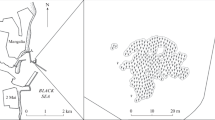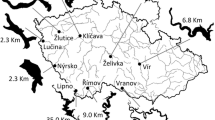Abstract
We analysed population dynamics of Daphnia galeatain littoral and pelagic areas of the long-term biomanipulated Bautzen reservoir during spring and early summer of two consecutive years. Simultaneously, consumption of the age-0 fish community was estimated by means of a bioenergetics model. As a consequence of biomanipulation, the abundance of adult planktivorous fish in Bautzen reservoir is low and the interactions between underyearling percids and Daphniaare a key process in the food web of this water. In both years, density and mean size of D. galeatawere markedly lower in littoral than in pelagic areas, whereas no differences were found in the size at maturity and clutch size. However, the lower proportion of adults in the littoral zone resulted in drastically reduced birth rates, which could not explain the strong fluctuations in Daphniaabundance. These findings were consistent during the whole investigation period. Daphniaconsumption by age-0 fish was markedly higher in the littoral than in the pelagic zone and accounted for up to 50% and even 100% of Daphniamortality in this habitat. However, due to gape-size limitation, age-0 fish did not feed on daphnids before June. We conclude that besides underyearling percids older planktivorous fish contribute to the suppression of D. galeatain the littoral zone of Bautzen reservoir and that recruitment of daphnids in this habitat mainly takes place via (active or passive) immigration.
Similar content being viewed by others
References
Benndorf, J., 1995. Possibilities and limits for controlling eutrophication by biomanipulation. Int. Rev. ges. Hydrobiol. 80: 519–534.
Benndorf, J., H. Schultz, A. Benndorf, R. Unger, E. Penz, H. Kneschke, K. Kossatz, R. Dumke, U. Hornig, R. Kruspe & S. Reichel, 1988. Food-web manipulation by enhancement of piscivorous fish stocks: long-term effects in the hypertrophic Bautzen reservoir. Limnologica 19: 97–110.
Boikova, O. S., 1986. Horizontal distribution of crustaceans in Lake Glubokoe. Hydrobiologia 141: 113–123.
Bottrell, H. H., A. Duncan, Z. M. Gliwicz, E. Grygierek, A. Herzig, A. Hillbricht-Ilkowska, H. Kurasawa, P. Larsson & T. Weglenska, 1976. A review of some problems in zooplankton studies. Norw. J. Zool. 24: 419–456.
Černý, M. & J. Bytel, 1991. Density and size distribution of Daphniapopulations at different fish predation levels. Hydrobiologia 225: 199–208.
Davies, J., 1985. Evidence for diurnal horizontal migration in Daphnia hyalinalacustris Sars. Hydrobiologia 120: 103–105.
Dörner, H., A. Wagner & J. Benndorf. Predation by piscivorous fish on age-0 fish: spatial and temporal variability in a biomanipulated lake (Bautzen reservoir, Germany). Hydrobiologia 408/409: 39–46.
George, D. G.& R. W. Edwards, 1976. The effect of wind on the distribution of chlorophyll A and crustacean plankton in a shallow eutrophic reservoir. J. appl. Ecol. 4: 445–465.
Gliwicz, Z. M. & J. Pijanowska, 1989. The role of predation in zooplankton succession. In Sommer, U. (ed.), Plankton Ecology; Succession in Plankton Communities. Springer, Berlin, Heidelberg, New York: 253–295.
Gliwicz, Z. M. & A. Rykowska, 1992. 'shore avoidance’ in zooplankton: a predator-induced behaviour or predator-induced mortality? J. Plankton Res. 14: 1331–1342.
Gliwicz, Z. M., A. Ghilarov & J. Pijanowska, 1981. Food and predation as major factors limiting two natural populations of Daphnia cucullataSars. Hydrobiologia 80: 205–218.
Haney, J. F. & D. J. Hall, 1973. Sugar-coated Daphnia: a preservation technique for Cladocera. Limnol. Oceanogr. 18: 331–333.
Hanson, P. C., T. B. Johnson, D. E. Schindler & J. F. Kitchell, 1997. Fish bioenergetics 3.0. University ofWisconsin, Sea Grant Institute, report WISCU-T-97-001.
Hülsmann, S. & T. Mehner, 1997. Predation impact of underyearling perch (Perca fluviatilis) on a Daphnia galeatapopulation in a short-term enclosure experiment. Freshwat. Biol. 38: 209–219.
Jakobsen, P. J. & G. H. Johnsen, 1987. The influence of predation on horizontal distribution of zooplankton species. Freshwat. Biol. 17: 501–507.
Lauridsen, T. & D. M. Lodge, 1996. Avoidance by Daphnia magnaof fish and macrophytes: chemical cues and predator-mediated use of macrophyte habitat. Limnol. Oceanogr. 41: 794–798.
Lynch, M., 1980. The evolution of cladoceran life histories. Q. Rev. Biol. 55: 23–42.
Macháček, J. & J. Matena, 1997. Diurnal feeding patterns of age-0 perch (Perca fluviatilis) and roach (Rutilus rutilus) in a steepsided reservoir. Arch. Hydrobiol. Spec. Issues Adv. Limnol. 49: 59–70.
Malone, B. J. & D. J. McQueen, 1983. Horizontal patchiness in zooplankton populations in two Ontario kettle lakes. Hydrobiologia 99: 101–124.
Mehner, T., H. Schultz, M.-G. Werner, F. Wieland, R. Herbst & J. Benndorf, 1996. Do 0+ percids couple the trophic cascade between fish and zooplankton in the top-down manipulated Bautzen reservoir (Germany)? Publ. Espec. Inst. Esp. Oceanogr. 21: 243–251.
Mehner, T., M. Plewa, S. Hülsmann, H. Voigt & J. Benndorf, 1997. Age-0 fish predation on daphnids-spatial and temporal variability in the top-down manipulated Bautzen reservoir. Arch. Hydrobiol. Spec. Issues Adv. Limnol. 49: 13–25.
Mehner, T., M. Plewa, S. Hülsmann & S. Worischka</del>, 1998a. Gape-size dependent feeding of age-0 perch (Perca fluviatilis) and age-0 zander (Stizostedion lucioperca) on Daphnia galeata. Arch. Hydrobiol. 142: 191–207.
Mehner, T., S. Hülsmann, S. Worischka, M. Plewa & J. Benndorf, 1998b. Is the midsummer decline of Daphniareally induced by age-0 fish predation? Comparison of fish consumption and Daphniamortality and life history parameters in a biomanipulated reservoir. J. Plankton Res. 20: 1797–1811.
Paloheimo, J. E., 1974. Calculation of instantaneous birth rate. Limnol. Oceanogr. 19: 692–694.
Patalas, K., 1969. Composition and horizontal distribution of crustacean plankton in Lake Ontario. J. Fish. Res. Bd Can. 26: 2135–2164.
Pijanowska, J. & A. Kowalczewski, 1997. Predators can induce swarming behaviour and locomotory responses in Daphnia. Freshwat. Biol. 37: 649–656.
Polishchuk, L. V., 1994. Cladoceran birth rate dynamics: does population characteristic of analysis reflect environmental control? Verh. int. Ver. Limnol. 25: 2369–2371.
Pont, D. & J. Amrani, 1990. The effect of selective fish predation on the horizontal distribution of pelagic cladocera in a southern French reservoir. Hydrobiologia 207: 259–267.
Siebeck, O., 1968. 'Uferflucht’ und optische Orientierung pelagischer Crustaceen. Arch. Hydrobiol. 35: 1–118.
Stibor, H., 1992. Predator induced life-history shifts in a freshwater cladoceran. Oecologia 92: 162–165.
Stibor, H. & W. Lampert, 1993. Estimating the size at maturity in field populations of Daphnia(Cladocera). Freshwat. Biol. 30: 433–438.
Stich, H.-B. & W. Lampert, 1984. Growth and reproduction of migrating and non-migrating Daphniaspecies under simulated food and temperature conditions of diurnal vertical migration. Oecologia 61: 192–196.
Urabe, J., 1990. Stable horizontal variation in the zooplankton community structure of a reservoir maintained by predation and competition. Limnol. Oceanogr. 35: 1703–1717.
Visman, V., D. J. McQueen & E. Demers, 1994. Zooplankton spatial patterns in two lakes with contrasting fish community structure. Hydrobiologia 284: 177–191.
Wu, L. & D. A. Culver, 1994. Daphniapopulation dynamics in Western Lake Erie: regulation by food limitation and yellow perch predation. J. Great Lakes Res. 20: 537–545.
Author information
Authors and Affiliations
Rights and permissions
About this article
Cite this article
Hülsmann, S., Mehner, T., Worischka, S. et al. Is the difference in population dynamics of Daphnia galeata in littoral and pelagic areas of a long-term biomanipulated reservoir affected by age-0 fish predation?. Hydrobiologia 408, 57–63 (1999). https://doi.org/10.1023/A:1017053820630
Issue Date:
DOI: https://doi.org/10.1023/A:1017053820630




